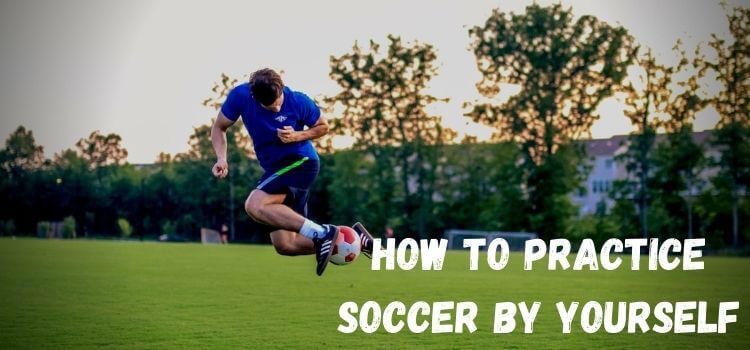As an Amazon Associate, I earn from qualifying purchases
Are you passionate about soccer but struggling to find time to practice with others? No worries! Practicing soccer by yourself at home can be incredibly rewarding and beneficial. Whether you aim to improve your skills, stay fit, or enjoy the game, solo practice can help you achieve your goals. This article will explore tips and tricks to make your home soccer practice effective and enjoyable.

Setting Up Your Practice Space
Choosing the Right Area
Finding a suitable space is the first step in setting up your practice area. A backyard, garage or spacious living room can work perfectly. Ensure the area is safe and free of obstacles that could cause injury.
Essential Equipment Needed
While you don’t only need a little time to get started, having the right equipment can make your practice more effective. Here’s what you might need:
- A good quality soccer ball
- Cones or markers for drills
- A wall or rebounder for passing exercises
- A goal or target area for shooting practice
Warm-Up and Stretching
Importance of Warming Up
Warming up before drills is crucial to prevent injuries and enhance performance. Your body is primed for physical action with a good warm-up that improves muscle blood flow.
Effective Stretching Exercises
To prepare your body, incorporate dynamic stretches like butt kicks, high knees, and leg swings. Follow up with static stretches, focusing on your hamstrings, quads, calves, and groin.
Ball Control Drills
Basic Dribbling Techniques
Start with simple dribbling exercises to improve your ball control. Use both feet to dribble the ball around cones, focusing on maintaining close control.
Advanced Ball Control Exercises
Once you’re comfortable with basic dribbling, try more challenging drills. Practice quick direction changes, step-overs, and feints to enhance your agility and ball handling.
Passing and Receiving
Practicing Short Passes
Find a wall or rebounder to practice passing and receiving. To increase your accuracy, target particular areas of the wall.
Wall Passing Drills
Stand a few feet from the wall and practice one-touch and two-touch passes. This will help you develop better ball control and quick reflexes.
Shooting Practice
Proper Shooting Technique
Focus on your shooting technique, including body position, foot placement, and follow-through. Practice shooting with both your dominant and non-dominant foot.
Target Practice Ideas
Set targets in your goal area or use a rebounder to create specific shooting challenges. Aim for different corners of the goal to improve your accuracy and power.
Fitness and Conditioning
Building Endurance
Soccer requires high levels of endurance. To build stamina, incorporate cardiovascular exercises like running, cycling, or jumping rope.
Strength Training Exercises
Strengthen your core, legs, and upper body with exercises like squats, lunges, planks, and push-ups. Strong muscles help improve your performance on the field.
Footwork and Agility
Ladder Drills
Use an agility ladder to enhance your footwork and coordination. Practice various drills, such as the in-and-out shuffle, lateral runs, and hopscotch.
Cone Exercises
Set up cones and practice weaving through them at different speeds. Your agility and capacity for swift direction changes will increase as a result.
Juggling Skills
Starting with Basic Juggling
Begin with simple juggling exercises to develop your touch and control. Use your feet, thighs, and head to keep the ball in the air.
Advanced Juggling Techniques
As you get better, challenge yourself with advanced juggling tricks. Incorporate moves like the around-the-world and neck stall to showcase your skills.
Developing Soccer IQ
Watching Professional Games
Watching professional games is one of the best ways to improve your understanding of soccer. Pay attention to player movements, strategies, and positioning.
Studying Different Play Styles
Analyze different playing styles and tactics. Understanding how various teams and players approach the game can provide valuable insights for your practice.
Using Technology
Soccer Training Apps
Several apps are designed to help you train effectively at home. These apps offer guided drills, workout plans, and performance tracking.
Recording and Analyzing Your Practice
Record your practice sessions to analyze your technique and progress. This might help you track your progress over time and identify improvement areas.
Mental Preparation
Visualization Techniques
Training physically is less vital than mental preparedness. To visualize yourself doing well in various gaming settings, apply visualization techniques.
Goal Setting for Soccer Practice
Establish quantifiable, precise objectives for your practice sessions. This can keep you motivated and focused on continuous improvement.
Consistency and Routine
Creating a Practice Schedule
Consistency is critical to improving your soccer skills. Make a practice schedule that works with your schedule, and try your best to follow it.
Tracking Your Progress
Keep a journal or use an app to track your progress. Note down the drills you performed, your achievements, and areas that need more work.
Challenges and Solutions
Common Obstacles in Solo Practice
Practicing alone can sometimes be challenging. You might need more motivation, more space, or distractions.
Solutions to Stay Motivated
To stay motivated, change up your routines, set realistic goals, and remind yourself of the advantages of practicing alone. Sometimes, inviting a friend or family member to join can make it more fun.
Conclusion
Practicing soccer at home is a fantastic way to improve your skills, stay fit, and enjoy the game. You can make significant progress by setting up a proper practice space, incorporating various drills, and staying consistent. Remember that hard work and an optimistic outlook are essential for success. So, lace up your boots and start practicing today!
FAQs
Doing practice at least three to four times per week is recommended if you want to observe consistent development in your performance. However, listen to your body and avoid overtraining.
You can improve your ball control by practicing juggling, dribbling through cones, and wall passes.
Absolutely! Many drills can be done in small spaces, like ball control exercises, passing against a wall, and footwork drills.
Setting goals, tracking progress, and mixing up your routine can motivate you. Additionally, remind yourself of the benefits and enjoy the process.
Get creative with what you have. Use household items as markers, and improvise drills that don’t require specialized equipment.
Read Our More Articles
- How to Coach Soccer to 5 Year Olds: Tips and Strategies
- How to Coach Kindergarten Soccer: Tips and Tricks
- How to Coach U8 Soccer: A Comprehensive Overview
As an Amazon Associate, I earn from qualifying purchases


